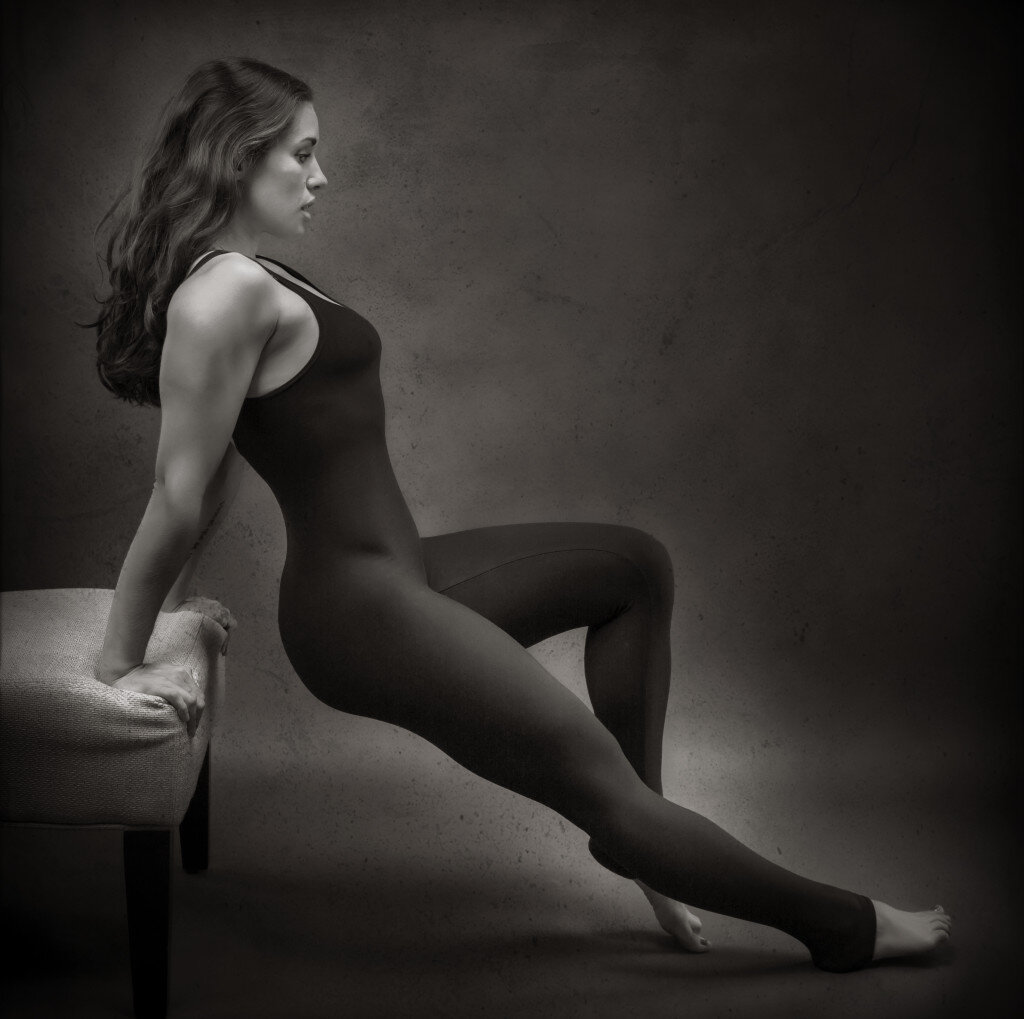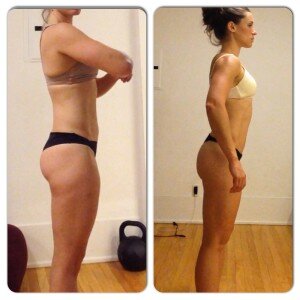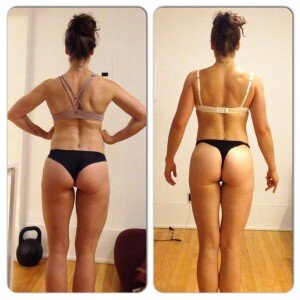Personal Training Update: 1 Year of bodybuilding and my personal coaching progress
JULY 10, 2015 BY FITNESSBADDIE
I’ve basically completed almost a year now of focusing on bodybuilding (it’s more like 10 months). When I say “bodybuilding,” I mean that I’m focusing on muscle hypertrophy, control and isolation specifically, with the intent to build muscle, correct my glaring imbalances, and fix my patterns in exercise that were off.
Below is the summary of my training and progress pics spanning this amount of time. At the end, I also included pics from a photoshoot I did last week, so you can see both the “normal” ones and the professionally photographed ones. Lighting and composition definitely make a huge difference, but please note that I did not diet, water or carb deplete, or do anything whatsoever to prep for the shoot. I woke up and drove for an hour with kids to do a quick shoot at 9:30 a.m. I only mention this because I am usually asked how I “prep” for a shoot (haven’t yet, at least). I don’t. Besides makeup.

Background before bodybuilding
I decided to focus strictly on bodybuilding for a couple of reasons:
I had some really nagging pain issues that were frustrating the fuck out of me. The variations of Big 3, kettlebell, and Strongman-style training I was doing were regressing me, not progressing me. If you would like to know more, I have written a couple posts on those struggles including, Coaching Tricks for Hypermobile Chicks, There Is No Such Thing As Perfect Form, Train Tall, Not Tucked.
As you will see in my pics. I can honestly say, physically, I started regressing after my Squat Everyday experiment, mostly because I hit the limit with load my body could handle without proper technique and appreciable muscle mass. This does not mean I “shouldnt” have done it (you can’t change what you have already done), and that it wasn’t valuable, it was. But I can only know that because I went through it, and realized my training was not suiting me, and or was not at a level that was appropriate. That’s it. Keep that in mind as you read this. This is STILL a personal training account, not a list of recommendations. All recommendations depend on context.
Also, I realized that how I thought of movement and training in PRINCIPLE needed a lot of work. Not principles in the text-book meaning, but more in how I processed and applied them physically in training. After all, what you are getting is a result of what you doing. I “felt” this, but knew I needed help “getting it.” While this doesn’t mean I was non-functional, it also kinda does mean it. My actual physical capabilities were decreasing relative to the work and effort I was putting in. I had limited balance, could not use my flexibility, didn’t even like the look of my muscles (or lack thereof) and had numerous performance issues and pain. Below, I’ve listed some of my most glaring weaknesses. I only had a vague sense of their severity until I started getting stronger again.
Balance.
Balance was absolutely backwards with me. I had none, in a basic sense, not even a complex one. My core and pelvis were weak and sunken. This threw off all my stability. Literally. I was grasping for stability, and this was exhibited (in MY example) as very tight neck/shoulders, tight hips, soft-looking legs, and lack of muscular tone in key areas. In training, when I started Muay Thai I was horrified. I could barely move around in space, much less with any speed or power! As my Muay Thai coach mentioned.
“Lifting heavy weights does not require balance (just lifting them, I don’t mean you shouldn’t have it to avoid negative stress/impact), but for power it is imperative. Power cannot be produced without balance.”
How could someone that can swing kettlebells and do pullups NOT have power? Because it’s not the exercise itself, but what your body NEEDS to learn before it can produce it!
As an example:
When I first started riding the subway, I could not stand without holding on (this was 2 years ago almost to the day, when I first moved to Toronto, July 4th, 2013). I could not find my balance and it bugged me. I began keeping this thread of “balance” in mind and watching bodies closely (always do). I began to test it every time I rode the subway (every day, 2-6x a day) and streetcars. As my training and alignment improved, it was cool to see how I can now easily stand without falling over or grabbing for something.
Today, I rode my whole way home (about 20 mins) without grabbing once (even on curves :P) and with my eyes closed, taking a semi-nap. While this doesn’t “mean” much per se, from an overall point of view, it was a clear example to me of basic improvement in body awareness and the ability of my core and back to stabilize me AUTOMATICALLY. This is also why I could never surf well hahah. Balance is huge.
Muscle innervation and isolation.
I realized I couldn’t really flex ANYTHING well. How can you claim to “have muscle” and not be able to flex any of it? The purpose of muscle is to CONTRACT and FUNCTION. This does not strictly mean aesthetics or how a muscle “looks”. But when you pair the visual with the functional and strike out on both……… well there ya go. So this glaring contradiction in my personal strength universe was hard to ignore. Yet as obvious as it seems, it was very hard to let go of the type of training I was doing. I wanted someone to tell me how farmer walks, heavy squats, and kettlebell cleans were still what I needed and “just do this one thing different.” I just got rid of the idea that the weight I used to lift was the measure of my strength and that getting back to that WAS strength. It is not. It can be. It just depends. I had to get rid of this notion in this context, or I would not fully engage in doing what was necessary. And it WAS necessary. I needed to change the way I thought about training muscle, because what I was doing was not giving ME any.
Limited motor control and coordination.
I used to be very coordinated as a child. In fact, I was known for it. I danced easily, and I like dancing. I played all kinds of games and had P.E. every day. I could always pick up moves easily, and things like cardio classes, Zumba and Tae Bo were easy for me to pick up. I wasn’t clumsy. Then, I started getting injured and things changed. I am very hypermobile, so sports and I just didn’t seem to get along, especially if it involved any type of speed, power, or force. But I kept at it all the way up into powerlifting. When I moved here to Toronto, I started broadening my training and ran up against some huge walls in how I moved after having a powerlifting/kettlebell/”strength in barbells” focus for the previous few years. Starting Muay Thai, and even trying salsa dancing, showed glaring holes in all my physical abilities. I sucked. And my back was hurting all the time. But, how I moved was tied into how I thought about moving and training, and Alexander Cortes emphasized this point when sending me my program.
When I decided to be realistic and look at my weaknesses objectively, they were right there for me to see, and they were pretty damn uncomplicated (in principle; i.e, my core was weak as heck, though that statement is simple, in practice, not so simple). Literally everything felt like it went backwards or opposite. My whole automatic stability “idea” in my head was firing backwards. All the cues I held on to in my head, my perceptions and physical interpretations of movement and what it “feels” like and the motor patterns I could identify in my head, were literally backwards. If you are familiar with the concept of stability vs mobility, you can get what I mean better.
I have reams of notes on the mental threads I had to rewrite (that is probably boring to anyone but me). I had an epiphany (one of many) when I started mentally cueing myself backwards when a movement or technique started to feel frustrating. I would cue the stabilizing or still aspect, rather than the moving one.
Being hypermobile, I found this useful for getting myself to relearn form withOUT overthinking it. My training became much simpler, but much more mentally exhausting. Yet, physically, my body started feeling lighter, more open, and more capable. I started being able to “hear” joints and sense changes in balance, breathing, and my center of gravity. I didn’t lose my base as much in Muay Thai, and that allowed me mentally to actually begin to see technique in Muay Thai. “Use your hips” started to make sense physically.
My back and core had been so weak, the signals got lost in translation. And that was clear in my leg function, which was horrible really. This is why my legs grew immensely in the last couple months. While my limbs felt lighter, I felt my hands and feet grow more sensitive. And I started to become aware of my limbs in space. I had always read about it, but I had lost it and when I was younger and before injury I never stopped to think about it (which is ideal!). I had to consciously regain it. Now the goal is to start training LESS consciously and more fluidly. But I had to first be aware of it, to change it. I now have a physical definition, personally, for stability, hips, and can mentally “feel” my body 10x better. I am physically more literate. I do believe this is “athleticism” and “listening to your body.” I can also (and this will sound so abstract) better understand the variables of training. I feel the disctinction between a max effort and a pump effort. An explosive effort and a max strength one. It’s like I couldn’t reconcile physically those terms while I still had the noise of basic malalignment and no “sense” in the muscles from basic hypertrophy training, i.e. bodybuilding.
Once I decided basic bodybuilding was needed, I needed help to free myself up mentally to start learning. I wanted to hand off the programming to someone else for this purpose. I think this is one of the best reasons to hire a coach. You have limited focus, so delegate when you can! Paul Hynes at Bang Fitness programmed for me for the first 6 months. During that time, I really worked hard to stop myself from fucking with the process. Like, sneaking in extra shit, or going heavier than needed, or giving up on an exercise and basically quieting all my assumptions about form, technique, and programming, etc. This was a very mentally consuming process for me, but it felt easier somehow once I got some help (no shit, Sherlock. Haha). The commitment to focus on one theme for my training made it easier to act and made me appreciate the time I had to work as well. And it did work. I could write multiple essays on the specifics of certain body parts, but let’s just say that they’re out there already by coaches better than me; you might just not know how to SEE it. I tripled my knowledge of training this past year, and how much I have to learn stretches before me as an endless sea of wonder.
I made the progress I aimed for the first 6 months and then decided to hire Alexander Juan Antonio Cortes from EliteFTS for the next phase. I liked his style, and we had chatted a couple of times. I knew what I wanted in a coach, and that was simply: they needed to be able to get what I meant. Alexander showed that consistently in our conversations. There were critical things I was dying to discuss with someone. I didn’t exactly know what I needed a coach to be like, I just KNEW when it wasn’t a fit. So I just waited. But when he showed up, I knew. And I was right.
Again, going into detail might take awhile, and perhaps with Alexander’s permission I can reproduce some of our conversations, as they are chock full of good stuff.
A good coach is worth their weight in gold. The program he wrote for me was the first time I felt I had received something very personalized. Not personalized because it was fancy, but personalized because it was both simple when it needed to be and complex where it needed to be. The diet plan was normal, but I didn’t want or need fancy. I have no allergies, I’ll eat anything, blah blah.
Here is my honest evaluation of my adherence to the program:
90-100% on training. While it took me about 2 weeks to feel I got in the groove of the training, I adhered to it faithfully and went beyond. I increased the volume of work I did, but the hardest part was increasing my focus in the training and my NEAT (non-exercise activity thermogenesis). I started walking more, climbing more, playing more. Purposely. As my pain subsided and my coordination increased, this became substantially more pleasurable to me. I also worked harder at taking time to plan my training, both in scheduling and intent. I kept my journal faithfully, and sat down to write out my program in pen before starting and make note of observations and cueing. I would say writing in a training journal is becoming a ritual for me after all these years. I’ve tried other ways of recording, and I go right back to pen and paper.
30-40% on diet. So let me explain a bit. The hardest part for me in diet I discovered was cooking and shopping. Where I was diet wise: I was not eating enough and eating very haphazardly. I give myself a very low score because I put the majority of my energy into my training. There were really key things I felt on a roll for learning, and the momentum drove me to put most of my energy there for the last three months. I felt this was right, and that I needed to go with it, so I did. But on the diet side, basically the only things I designed to change consistently up to now were making sure I had a protein shake almost every day. Eat more often, not wait till the afternoon (I had picked that up doing IF, but started to prove useless and becoming a lazy habit rather than a truly beneficial one). I also made myself cook more. The more I cooked, the more the kids ate, the more groceries I had to buy, and basically I got a firsthand lesson in the challenges of truly changing your diet … yet again. But just at a different point in my life, and with different context.
60-70% total compliance. A bit too low, but when you imagine that I think about training all day and have MORE motivation than most, and MY adherence was this….what does that tell you about those who are just starting? It simultaneously humbled, shocked, and sobered me. Honestly looking at what you want to do, then what are doing, and then what you CAN do is very important. Good enough, is all there is. But first, you must get to GOOD. The cool thing is that the ceiling is high and always unreachable 😉
I feel now that certain (previously overwhelming) training focuses can take a back seat for a bit and I can spare more mental energy for setting up a more reliable diet system. If you look at the pics and imagine that I only did a fraction of what I could have been doing diet wise, you can imagine the impact on progress. I do not deny that.
Yet, I am OK with that, simply because my objectives were obtained. Honestly, I feel I had to sort through some mental stuff first before sharing my focus with another large variable like diet. So I changed the basic stuff, and left the rest. All that to say, plenty of room for improvement. And now I feel capable of placing attention there and actually implementing successfully.
My work capacity has shot up. I train every day and sometimes 2x a day. I do lots more low-level work than before that does not truly “count” as training per se (but is still considered in energy needs, as I have to monitor whether my body is handling it all well). This consists of:
- Barre class 2-3x a week
- Running 1-2x a week
- Climbing in the park
- Spending a couple of hours on the monkey bars and parallel bars
- Walking
All of that was added, but bear in mind that only the first two were “formal” in the sense that they had a time limit, a location, and structure and were physically demanding by mentally easy. And even then, I want to make a distinction between mentally formal and mentally informal. All the above were mentally INFORMAL to me, and I feel that impacted my energy and recovery positively (read Squat Everyday by Matt Perryman to explore this theme more). As in, I didn’t do this kind of work for the purpose of a specific fitness goal, but more for enjoyment, practice, and fun. Therefore, my perceived “stress” from all the added movement was: none. And my work capacity increased without negative side effects. My ability to handle more training has doubled. In fact, if I start eating like I could, who knows … haha. I feel I am finally reaching that stage in which diet will really start mattering more. As in, eating more calories and caring harder about nutrients and timing. That of course depends on if I want to, but progress is addicting and my real lasting resolution now is to stay in the state of mind that allows for consistent progress. Not get hung up demanding something work for me, but examine how I perceive the work, what it means, and what I am really doing.
But really, what else is there to life but training? Hahaha. I love training! Or more like, I love that I can now truly love training because I got over some frustrating humps.
Formal training was my weight training 3-4x a week, and my Muay Thai class 1-2x a week. That was the training that required a lot of mental focus and therefore was harder and more tiring for me. But I can definitely focus easier and more quickly now. My ability was very low when I first started Muay Thai: the ability to listen and maintain focus and follow instructions as well as physical abilities. In fact, it was downright embarrassing how shitty a listener I turned out to be when the tables were turned. Training has felt progressively amazing and exciting for the last year. I wish that feeling for everyone, as a coach, but also as the client, because my intrinsic motivation (which was higher relative to most if we grade on a curve) has also increased. This means my capacity for progress just got bigger.
In my case, I can find direct ties in my physical weaknesses to mental weaknesses. As Alexander wrote to me,
“your body is not separate from your brain. You move the way you do because of how you think about movement. And how you think will determine how you move.”
On a rest note, during the last 6 months, there was approximately 2 full weeks when no intentional training was done. But I honestly hate not training, and it bothers me when I can’t.
What did I learn?
Everything. So much. Massive, massive amounts of things to learn still. Can’t even begin.
Ok, here are a few key points.
– I needed to do a lot of right work. To do that, I had to know what “right” meant for my body in terms of feel. But first, I had to stop doing all the unnecessary work, the shitty work! It cluttered by ability to SEE what was needed. I knew this, I just didn’t apply it to myself. What you need to do is NOT the same as what you want to do IF (and IF is a keyword here, people) you are not making progress and getting what you want. No matter how much someone tells you that, “Yeah, you just gotta squat” or “But that’s the best for the abs” (which is how EVERYONE thinks of exercise), it doesn’t mean that’s what you NEED. To find out what you need, you have to be able to clear your head of all those ridiculous expectations about fitness, and just show up and for the time you spend doing it, actually do it. Not wish you could be doing something else, like “that girl over there!” (pout).
People get hung up on doing exercises for an ego boost, rather than because it will make them fucking stronger. We all hear that. We all like to think that’s not us. Hey, it WAS ME. That’s why everyone hates correctives. No one wants to spend time breathing. It’s why you can’t convince someone that it’s a simple fix in technique, not a specialized problem, or even that they are just doing it wrong. Or that they are not doing enough. The point is that it doesn’t matter what it is specifically, it’s that the only thing you need to know is what you need to know. Geoff Girvitz said something awhile ago in a conversation when were discussing client progress, and it stuck with me. Made me wonder if I did that….he said, and I paraphrase, “The ones who really make progress are those who can do a lot of the average, not so exciting stuff consistently.” I can’t remember his exact words, but the basic gist was that, you can tell a lot about how far someone COULD be capable of going by what they are willing to do. Especially if they go out of their way to hire a professional to help them do it!
And if you can’t do it, you don’t know it. The only thing to do is find what is needed. And you can’t do that lying to yourself about what you’re ACTUALLY doing.
Maybe you are way weaker than you’d like to think (as I was, in my case) and it’s hard to be objective about it. No one likes feeling like they are going backwards. But how is doing what’s needed backwards? It is THE ONLY WAY forward. When you change that in your head, you change your motivation to do the necessary stuff. Or you’d rather just wander in a circle? That IS the other option. Don’t wish you could train another way; find why you suck at training that way. You don’t get stronger by bemoaning the fact that you weren’t “meant to do that.” You don’t have enough knowledge or expertise to make an educated guesstimation of your potential. So don’t shut yourself down by doing so! It is so pointless.
– You need mental energy for training, or physically, you won’t ever reach that point in which you start feeling engaged and owning the work you put into your body, and getting the kind of results you see some people get. Your results are individual to you and WHY you are training. Why is everything. The why is everything.
Think about your why. Your why is your motivation. It will change. That’s OK. Start thinking about it. And eat your carbs. Your brain runs on glucose, baby.
– The only things worth worrying about are those you have control over. And once you start LOOKING for control, you find it everywhere. “Oh look, I can control that, I can control that, I can change that, yup I can take care of that.” Can you see how that attitude is connected to physical change as well? Suddenly, there’s so much you CAN DO. This is not the same as making yourself busy and hectic. That’s just another form of laziness.
– Put in the time. No one knows how hard or long they will have to work until they start. You can’t predict it. Everyone wants to know exactly how long it will take. That’s impossible to tell! It’s guesstimation. All you can do is start the work according to the protocols best proven for success! You might have to work 10x as hard as the other guy, but it’s that or don’t do the work. Or just be honest about how much you are actually doing. Like, really honest. Not just casually mentioning your sleep or “stresssssss” or that it’s really just because you had a few pizzas last week. It’s actually identifying stuff, taking action if you need it. Anything weak about yourself is your fault. Whose fault did you think it was?
My goals now
I am committed to staying on the “bodybuilding and hypertrophy” theme in my training until I feel I have milked this cycle for what it’s worth. Bear in mind I am not a bodybuilder (no plans to compete, etc.). I train for physical ability and aesthetics. As of now, I compete in no sports.
Soon, I will bias toward strength for a bit, as my patterns and technique have cleaned up and my major physical imbalances are solved. As always “strength is the basis for all athletic endeavors.” There are many types of strength, so that’s why I said “theme.” But in this paragraph, I DO mean putting back in some more traditional barbell work, but with a focus on fluidity, speed, and technique – not just weight. Also, I am slow, so speed strength and max strength are always important. Guess we’ll see what my coach says.
My primary training goals are: improving my skills in Muay Thai (intense and scary), and Barre (severely enjoyable to me, plus allows me to develop my flexibility + strength in a way I really like. Cause lettucebehonest, my childhood dream was being a ballet dancer), and looking good naked (just good common sense).
Between these three, I feel I am getting well-rounded input kinesthetically. Since I am not training sport-specific, but still basically general capacity, no reason to specialize really. That may change in the future.
Last thoughts
A lot of people have asked me what I did specifically for certain issues, especially my imbalances, knee pain, and SI joint pain. I don’t really want to say what I did specifically in terms of exercises and sets and reps simply because that was really the arbitrary stuff and nothing new. It was more about examining how I thought about movement and broadening my “vision” of what strength was, as much as it was specific exercise work. And it was a lot of work as well, physically. I had to DO MORE, THE RIGHT WAY. If you don’t know the “right” way, you need to find someone who can help you examine that. Not just in terms of exercise, but in terms of examining how you think of what you are doing, especially if you keep running into consistent issues.
Also, recommendations are only useful if they are suitable to you. To be suitable to you, one must know you and your background. I can now see certain approaches to therapy and movement theories much better and grasp “what is meant” when I study stuff like PRI, Anatomy Trains, or specific therapy papers. But as I am not a therapist; I still can only comment extensively on the the training process.
I will say this though: If you have significant frustrations, get a coach. Find someone. You need someone to actually get their hands on you. That’s my best advice, and I try to connect people in my network to each other as much as possible, even cross-country. Thankfully, social media makes this easier, so that I can at least have a decent sense of someone’s methodology and expertise over time, even if I don’t really know them personally. I find this very useful for helping the right people find each other. Some people can “get it” by reading, discussing, etc., but if it takes a real dedication to delving in. Coaches need coaches etc, I’m sure you’ve heard that.
But from a client standpoint, this means; guard your mental energy just like your physical energy. Invest in someone who can do the “thinking” part for you, so you can focus on showing up ABLE to listen and work.
Building the body is a lot of work. That’s why elite athletes have a posse of coaches, therapists, a psychologist, and nutritionists. To perform at that level, you NEED all that. Now think about yourself and your lowly goals (lowly relative to them physically, not lowly in importance to you), and imagine HOW MUCH LESS you do than them WITHOUT their genetics. That will give you a reality check on how much work you might need to put in to get what you might consider “real results” for yourself – or whatever fantasy body or performance capability you have in mind. Always look to yourself first for what is lacking. You’ll usually find it. And then, suddenly you’ll start to understand that most famous of phrases:
Stick to the basics.
Master the basics.
Pros are better at the basics than anyone.
Capiche?
Pictures:


Biggest progress was in alignment, motor control and balance. My progress was not “amazing” by any means, hahah, but you must also consider the rate of my compliance above and my focus. If other trainers have questions about the more delicate comparisons in alignment, shoot me a message and I’ll answer best as I can. My ability to understand movement in others has also increased exponentially, which is why I have had some success in helping clients “fix” certain issues in training. Clearly my body is only one body, and only mine. I need to see lots of bodies!
Some Data:
4x/week bodypart split. Organized as:
1.) Chest, Back, Triceps
2.) Glutes, Hams, Biceps
3.) Shoulders, Back, Forearms
4.) Quads, Abs, Calves
Plus the approximately 8-10 hours of purposeful NEAT activity and class.
*As mentioned the exact routine was personalized, so no point writing it all here.
Guiding principles for intent in order from most “big picture” to most “specific:
- Build muscle
- Progress reasonably (weight going up is not the main factor, or the strict factor by which progress is judged. It was ABSOLUTELY imperative for me to accept this.)
- Develop muscular CONTROL of my limbs.
To correct imbalances specifically, Alexander had me apply 3 “rules” to my training as opposed to any specialized corrective drills/work. I am quoting him directly here:
- Weak side rule (my left in this case). For unilateral exercises, say a split squat, you will perform the first set on the weaker side.
- First set, last set rule. You will also perform an additional set on the weaker side. Obviously this adds on extra volume that is unaccounted for, but that’s the point. Rather than obsessively targeting asymmetries, you’re simply doing a little extra work that will accrue over time (excellent approach for certain people, adopted this to my “solution arsenal” immediately.)
- Muscle activation drills. This is an Ian King principle that I’ve adapted. You are essentially going to be practicing “flexing” before movements. (Flexing and posing is hard. Really helps orient yourself to the FUNCTION of the muscle, which is tied into its “appearance” as well. Not always, and I don’t say this as absolute statement, merely one that fits MY INTENT in doing so.)
Starting Weight Range: 132-134
Ending Weight Range: 129-132 (slightly lower, body composition looks better, again, diet was very casual)
Starting RHR Range: 60-66 (MORE often)
Ending RHR Range: 56-60 (MORE often)
*heart rate testing first thing in the morning often tells me a lot about the stress of the previous day’s session for training-ability purposes the next day. IE, after a hard, good training, woke up with 78 HR. HR would also increase from lack of sleep, lazy stress (as in, not obvious stress), not eating for awhile, and on my monthly.
Cardio Starting Range: Treadmill 0-8% incline, 3.0-5.0 speed walk/run. Walk only. Running was completely inefficient still, legs didn’t work yet. HR post-cardio 85 max. Steady state running/jogging – None.
Cardio Ending Range: 0-8% incline. Minimum speed (even at a walk) 4.5-16.0 (FIRST time, I have ever been able to sprint on a treadmill over 12!). Steady state: 20 mins 8-11 speed. Sprint 15-30 seconds 11-16 speed.
My true performance increases were in:
- Retraining motor patterns and technique
- Regaining balance and “feeling” my hips, core and the subtleties I needed to. I COULD NOT DO THIS WHILE I WAS PREOCCUPIED WITH BEING “ALLOWED” to keep doing exercises for the exercise, rather than the PURPOSE.
- No nagging SI pain
- Increase in work abilities and capacities. Basic physical literacy. “Joy, balance on one foot.” Ok, no problem (stupid example, but that’s what I mean).
That being said, all reps/weight did go up, but since that wasn’t the intent, again, no point listing it specifically.
At the end of the day, if you take ONE thing away from this goddamn book of a blog post, it’s this: 80% of the change was mental. 20% was physical increase in work. ESPECIALLY BECAUSE I WAS COMING FROM A PLACE OF what we all like to call DYSFUNCTION or IMBALANCE. It wasn’t the exercises themselves that were “wrong”. Everyone always argues this, and it’s a shitty argument because it’s a bad question.
“Change. Because direction is more important than speed.” – Unknown
Achieve your nutrition and training goals with Joy’s expertise and support.
Get started now


